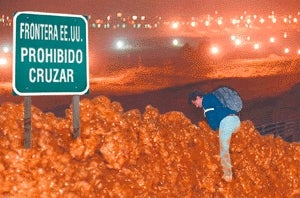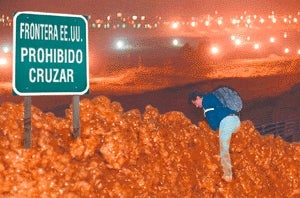EL PASO, TX—In an effort to beef up security measures along the U.S.-Mexican border, the U.S. Immigration and Naturalization Service announced Monday that the border will soon be fortified with 1,200 miles of pure beef.

“America has drawn a line in the sand,” INS official Frank Wilhelm said. “And that line is made of meat.”
According to Wilhelm, the immense, 15-foot-high wall of pure beef, which will extend from the Pacific to the Gulf of Mexico along the Rio Grande, will make border crossing all but impossible.
“This beef will be cooked sizzling hot, so hot that it will be extremely painful to climb over,” said INS chief Kent Roker. “And even if a Mexican does get across, they will be so full that they won’t run far.”
Just this morning, Ciudad Juárez, Mexico, resident Jorge Gutierrez, 43, a poor, unskilled laborer who had managed to successfully climb over the beef barrier, was found by Texas state troopers sitting by the side of the road, holding his belly, picking his teeth, and moaning, “Aye, caramba, am I stuffed!”
Border Patrol authorities described Gutierrez’s condition as “full,” adding that the would-be immigrant did not run or hide when spotted, due to sleepiness and lethargy induced by consumption of enormous quantities of beef.
Gutierrez was treated at nearby Santa Maria Hospital for indigestion and extensive second-degree grease burns; given new clothes; and then turned over to INS authorities for deportation.
Those who, unlike Gutierrez, do manage to escape are “easily tracked” by INS dog teams, specially trained to follow the scent of the spicy, mouth-watering seasonings the federal government stirs into the sizzling hot beef wall twice daily.
“This is real beef, for real Americans,” INS official Ted Stake said. “Most of your foreigner types just don’t have the stomach for that much hearty, lip-smacking meat, living as they do on subsistence diets of tortillas and beans.”
Though the beef wall already has had an enormous effect, reducing the number of illegal entries to the U.S. by 35 percent over the last week alone, the project has not been without its costs.
“The harsh climate of the Southwestern U.S. is largely inhospitable to perishables such as the grease-slathered mounds of meat used in the beef shield,” said Department of Agriculture Undersecretary Joseph Timmins. “Temperatures along the Rio Grande can reach 110 degrees in the shade on a typical afternoon, and for an operation like this, that means one thing: spoilage.”
At present, the U.S. is spending over $22 billion per week to deliver massive rail shipments of fresh beef to the border three times a day. Budget constraints have necessitated the elimination of a planned $75 trillion grease trap to catch the runoff from the beef barrier’s massive hot plate base. Currently, every 60 seconds, 300 tons of congealed grease are dumped directly into the Rio Grande, with environmental damage in the last week alone estimated at $759 billion.
“That much beef is a tall order,” Timmins said. “But that’s how we do things here in the good old U.S. of A.— big, meaty and ready to take on even the hungriest of hombres. So bring it on, illegal aliens: Let’s just see if you’ve got the stomach to take on this much hot American beef.”
Timmins concluded his remarks by holding up a forkful of ground beef, placing it next to his mouth, and smiling directly at the asssembled press, saying: “Mmm… beef!”







